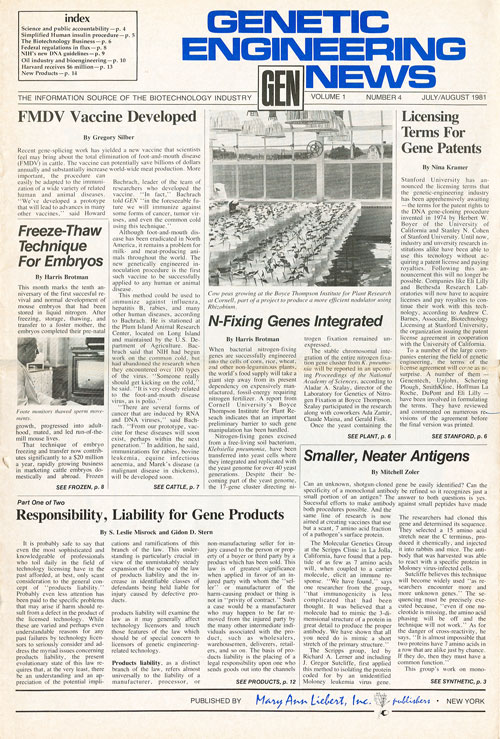April 15, 2011 (Vol. 31, No. 8)
Editor’s Note
Without Drs. Herbert Boyer and Stan Cohen, the biotechnology industry would probably not exist, or at least appear in the form that we currently know it. And, of course, there would be no GEN. However, these two scientific pioneers developed THE basic biotechnology—recombinant DNA—and the keystone was set for the establishment of a brand new and global life science business. The rest, as they say, is history.
As Nina Kramer’s July/August 1981 GEN article notes, until Stanford University set forth the terms covering the famous Cohen-Boyer patent (two patents were actually involved under the agreement), almost anyone could use the technology without obtaining a patent license and paying royalties. The university’s announcement not only determined the playing field for those wishing to enter the biotechnology world but it also served notice that universities and academic centers would now be playing a more powerful and wide ranging role in the future evolution of the bioindustry.
This story is the latest example of our decision to reprint an article from one of GEN’s early editions in each issue in 2011. All these stories demonstrate a particular significance and relevance for the biotechnology community.
—John Sterling, Editor in Chief
Contest Alert
There is a mistake on the cover of GEN (shown below) that never happened before or since in all our 30 years of publication. Can you tell us what it is? Be one of the first 25 readers to identify the mistake and you will win a prize. E-mail your answer to [email protected]. Good luck!
“As Seen in GEN–Flashback” Volume 1, Number 4, July/August 1981
Licensing Terms for Gene Patents
by Nina Kramer
Stanford University has announced the licensing terms that the genetic engineering industry has been apprehensively awaiting—the terms for the patent rights to the DNA gene-cloning procedure invented in 1974 by Herbert W. Boyer of the University of California and Stanley N. Cohen of Stanford University. Until now, industry and university research institutions alike have been able to use this technology without acquiring a patent license and paying royalties. Following this announcement, this will no longer be possible. Companies like Eli Lilly and Bethesda Research Laboratories will now have to acquire licenses and pay royalties to continue their work with this technology, according to Andrew C. Barnes, Associate, Biotechnology Licensing at Stanford University, the organization issuing the patent license agreement in cooperation with the University of California.
To a number of the large companies entering the field of genetic engineering, the terms of the license agreement will come as no surprise. A number of them—Genentech, Upjohn, Schering Plough, SmithKline, Hoffman La Roche, DuPont and Eli Lilly—have been involved in formulating the terms. They have reviewed and commented on numerous revisions of the agreement before the final version was printed.
This final agreement covers two patents: one is for technology or method which was issued in December of 1980; the other is for the product, for which the patent is still pending. The DNA gene-splicing procedure, of course, is the well known five-step process: cleaving or cutting of a gene sequence; splicing in of a desired gene; inserting the recombined DNA into a host organism; growing that organism; and finally, expressing the new gene in a product. The product patent is for plasmids and single-cell transformants.
The licensing of this technology, Barnes points out, is very significant and unique in that it is “basic” to and “underlies” the entire industry of genetic engineering: its applicability to chemicals, pharmaceuticals, energy, food, and agriculture holds a promise for widespread and variant use. Stanford’s Office of Technology Licensing expects a “powerful” response to this announcement. It anticipates about 200 immediate requests for copies of the licensing contract and hopes to see a majority of these requesters become signatories by December 15, 1981, the date at which the offer of favorable terms to early licensees ends. Ultimately, the Office expects that all 200 companies presently involved in genetic engineering will purchase the patent rights.
Barnes reports that Stanford, which will split the net proceeds with the University of California, will put most of these funds into various research and funding programs at Stanford, particularly in genetics and medicine. It is interesting to note that neither Boyer, a founder of Genentech, nor Cohen, a consultant to Cetus Corp., will pocket their sizeable shares of the royalties. Both will donate their proceeds to further research at their respective institutions.








